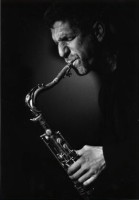
The tenor saxophonist Bob Berg has died, on 5th December, 2002 at the age of 51, in a road accident in Amaganset, Long Island, NY, USA .
Bob Berg had long earned the right to be included in the small select group of acknowledged tenor saxophone jazz masters, Coleman Hawkins, Lester Young, Ben Webster, Stan Getz, Sonny Rollins and John Coltrane. Born in 1951, Berg was the one of the few players of his generation who can be said to have joined them.
Born and raised in Brooklyn, he started listening to jazz from around the age of thirteen. At eighteen he dropped out of the High School of Performing Arts and enlisted at Juilliard for a year on a special non–academic, totally music curriculum. By this time he was playing both tenor and soprano saxophones and was already being greatly influenced by John Coltrane.
After Juilliard he became deeply involved in the free jazz experiments of this period, but became quickly disillusioned by them. Thoroughly sick of everything to do with free jazz, he went back and began to study the modern jazz classics, such as the Miles Davis, John Coltrane and Charlie Parker output of the 1950s. Indeed—he became vocal in his condemnation, not only of free jazz as a whole, but also of the jazz/rock fusion that followed. Throughout the 1970s he concentrated determinedly on playing acoustic bebop: such as typified by Art Blakey and the Jazz Messengers, and earlier by the groups pioneered by Dizzy Gillespie and Charlie Parker in the mid–1940s. This led up to the period 1974 to 1976 when he played with Horace Silver, and between 1976 and 1981 with the Cedar Walton Quartet.
Bob Berg was a phenomenal player of the tenor saxophone. His music was a flexible reinterpretation of hard bop, fast and dazzling. He was a natural swinger. Berg displayed a flawless technical command of his instrument through its every register at even the fastest tempo; melodically as well as harmonically sure, with the ability of being able to negotiate exceedingly difficult chord sequences with apparent ease, together with a big sound that owed much to the influence of Sonny Rollins and Coleman Hawkins, rather than that of Lester Young.
"...however, it was, or had been, in the first part of the set that Bob Berg had turned it all on. Suddenly, just after Miles had complained about the falling temperature, and a flunkey/ roadie had dashed on to bring him one of his sequinned jackets, Berg stepped forward to embark upon a long solo based upon an anonymous theme which was stunning in its impact and, for me, completely dominated this part of the programme. Miles must have thought so too, because when it was eventually over he brought Bob forward again to the front of the stage with arm upraised, in triumph. It was, as I've said, a very long solo, very fast and multi-noted, boomed out with a huge tone. But the dazzling display of improvised ideas came across with unending melodic continuity. Even some of the best jazzmen are known to pause for fresh inspiration in the middle of an extra-long solo. Not so this man. He simply careened on but never fell off the path. It was all remendously creative and exciting, and one realised that Miles was at last playing alongside a saxophone again blown by someone of real stature. The best since Coltrane and then Wayne Shorter." Raymond Horricks in 1989
"A great guy and wonderful player—worked hard all the time. I remember him on the floor of my loft with twenty other guys on 19th St in 1969 coming up with the name of the co-op we put together—Free Life Communication—same roots—Brooklyn neighborhood. Life is not fair. Count every minute and quarter note. Peace." Dave Liebman
"This is very sad news. Anytime a brother is lost, it's hard to justify. Bob was a great player. The saxophone world will not be the same." Mel Martin
Copyright © 2001, Jazz Professional. All Rights Reserved